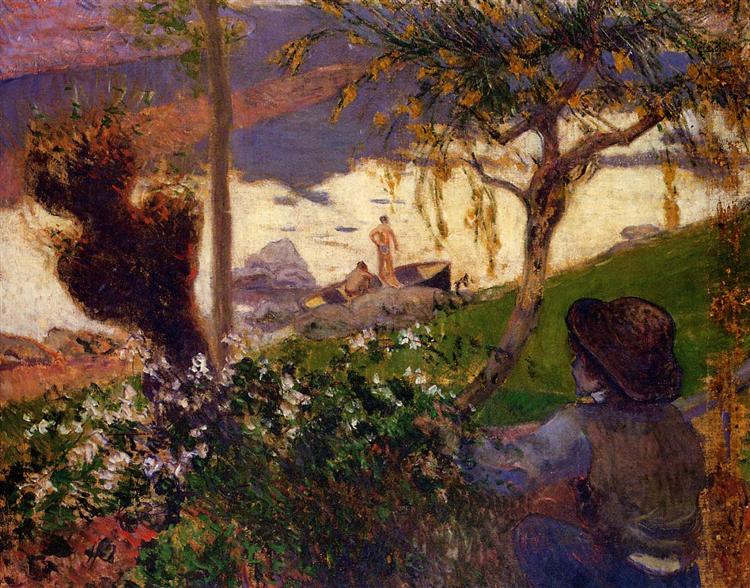Description
Paul Gauguin's "Breton Boy by the River Aven" created in 1888 encapsulates the essence of a moment in a rich and vibrant culture, while radiating the author's distinctive individuality. In this painting, Gauguin presents a young Breton boy, whose racial and cultural characteristics are magnified through his stylized depiction. The boy, dressed in traditional attire, is centered in the composition, prominently placed in the foreground. His seriousness contrasts with the softness of the surroundings, creating a visual dialogue between humanity and nature.
The choice of colours is fundamental in this piece. Gauguin employs a bold and vibrant palette, with a predominance of greens, blues and yellows, which not only captures the essence of the Breton landscape, but also provokes a visceral emotion in the viewer. The blue and green hues of the river and vegetation intertwine harmoniously, while the colour of the boy’s suit stands out, drawing attention to his central figure. These chromatic choices are characteristic of Gauguin’s post-impressionist style, which sought to evoke not only the faithful representation of reality, but also a deeper emotional connection.
The composition is balanced, with the boy on the left, looking at the viewer, catching his gaze and creating a connection. Around him, the landscape flows naturally, with the line of the river seeming to continue into the background, guiding the eye towards the horizon. The way Gauguin arranges the elements on the canvas is a reflection of his interest in the relationships between the characters and their environment. This relationship, however, is presented in a somewhat idealized and symbolic way, in which the natural and the human are not in conflict but coexist harmoniously.
It is interesting to note how Gauguin, in this period, was drawn to rural life, especially in Brittany, where he found a captivating contrast to the modern, urban life he had known. This work, along with others from the same period, such as The Day of the Feast and The Child of the Forest, demonstrates his growing interest in issues of cultural identity. By choosing to depict a Breton child, Gauguin not only celebrates the uniqueness of this culture, but also raises questions about innocence and a deep connection to the land.
His focus on the young figure embodies an exploration of purity, a theme that would appear later in his work, especially during his stays in Tahiti. Throughout his career, Gauguin would demonstrate a growing desire to escape convention, seeking refuge in cultures that he perceived as more authentic and less corrupted by European civilization. Breton Boy by the River Aven is thus a microcosm of Gauguin's fascination with ways of life that were often threatened by progress and modernity.
This painting, though it might initially appear simple in its depiction, is actually a testament to the complexity of human interactions with their environment in the late 19th century. The work invites the viewer to see beyond the boy at the River Aven, suggesting a universal search for meaning and belonging, elements that would continue to resonate in Gauguin’s art and in later modern art. In short, Breton Boy at the River Aven is a key piece in understanding not only Gauguin’s artistic evolution, but also the encounter between art, culture and nature at a time of great social and artistic change.
KUADROS ©, a famous painting on your wall.
Hand-made oil painting reproductions, with the quality of professional artists and the distinctive seal of KUADROS ©.
Painting reproduction service with satisfaction guarantee. If you are not completely satisfied with the replica of your painting, we will refund 100% of your money.

